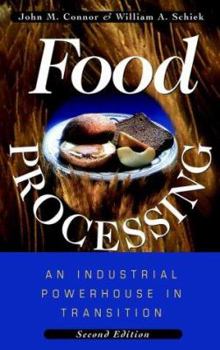Food Processing: An Industrial Powerhouse in Transition
Die zweite Auflage des Bestsellers zu Wachstum, ?konomischer Entwicklung und zum Gesch?ftsmanagement der Nahrungsmittelindustrie der Vereinigten Staaten - eines der gr? ten US-amerikanischen Industriezweige. Mit aktuellsten, ?bersichtlich tabellierten Informationen zur Produktentwicklung, Biotechnologie und Globalisierung. ?u erst interessant auch f?r europ?ische M?rkte, die die US-Entwicklungen verfolgen wollen.
Format:Hardcover
Language:English
ISBN:0471155152
ISBN13:9780471155157
Release Date:May 1997
Publisher:Wiley-Interscience
Length:688 Pages
Weight:2.43 lbs.
Dimensions:1.5" x 6.4" x 9.5"
Customer Reviews
1 rating
"...an authoratative...guide to food industry statistic..."
Published by Thriftbooks.com User , 25 years ago
Review by James M. MacDonald, Economic Research Service, USDA, appearing in the American Journal of Agricultural Economics, February 1999, page 252-253."Food Processing: An Industrial Powerhouse in Transition," by John M. Connor and W. A. Schiek, is not a textbook, and it doesn't contain much economic analysis: it is best thought of as a data handbook with commentaries.Connor and Schiek (C & S hereinafter) provide a ready source of numbers on a wide variety of industry topics, and the industrious reader can use the table source citations as a ready research guide to the available industry data sources.Given the authors' goals and the inevitable space constraints of the book. I don't believe that they could have included more analysis.On topics that energize them, such as that on food demand and consumer choices in chapter 8, the book does a very nice job of interweaving basic theory, the results of formal demand analyzes, and the information that can be gleaned from item-level supermarket scanner data, while at the same time conveying the strengths and weaknesses of the several data sources for the issues at hand. This section provides a very nice overview on key issues on the demand side of food marketing, and I expect that I'll rely on it frequently. But on other topics, such as the very lengthy chapter on location, the presentation turns repetitive.One of the book's real strengths lies in its demonstration of the variety of different data sources, aside from the well-known Census of Manufactures, that provide useful support for analyzes of food processing. Experienced researchers as well as managers, analysts, and grad students should be able to mine these pages for new and improved sources of information.C & S show a keen appreciation of the construction of food demand and consumption measures, along with the strengths and weaknesses of the associated data sets. Similarly, they show a sophisticated understanding of market structure statistics in a short space, and accurately convey the difficulties inherent in attempting to measure rates of new product introductions. But I'd like to see some closer attention paid to the problems of developing useful price indexes.In general, C & S provide an authoritative one-stop guide to food industry statistics and to the construction of those statistics--the footnotes can almost be lifted out as a separate commentary on data construction. While I wouldn't suggest that anyone should try to read the book through in a few sittings, it should continue to occupy a market niche as an indispensable quick source for anyone relying on food industry statistics.





